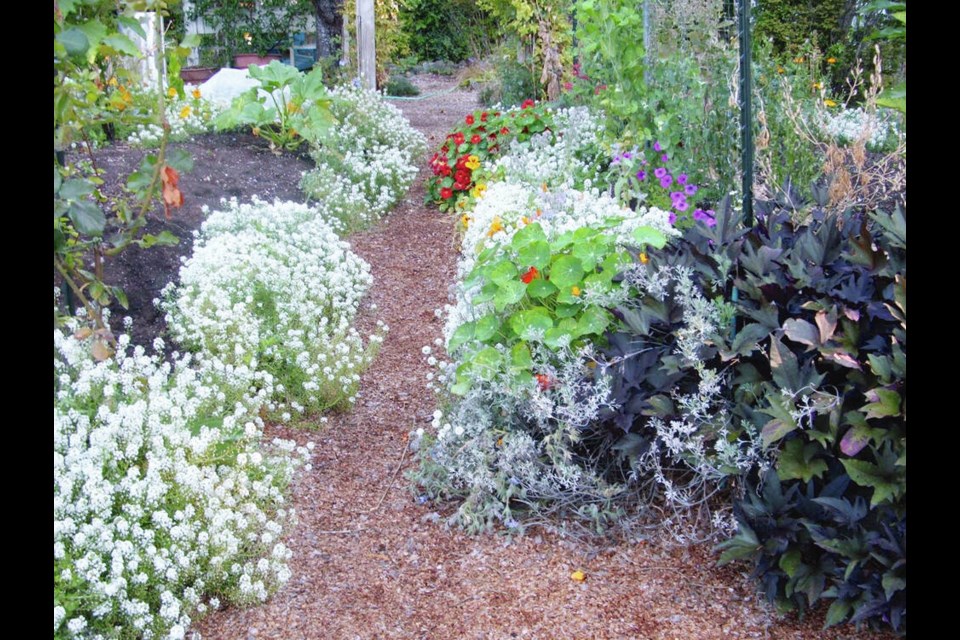Early in the spring I decided to spruce up the vegetable garden with flowers planted along plot edges. The space is divided into four plots by a central path and a cross path.
The results have been gratifying. Calendulas edging one plot have been colourful, and will self-sow. Nasturtiums spilling onto a cross-path in front of stout, bushy kale plants have been close to spectacular.
Along both sides of the centre path I seeded alyssum, which was joined by a collection of “volunteer” annual flowers to create a charming blend of billowing white alyssum interspersed with self-sown nasturtium, larkspur, borage and California poppies.
At one corner of the centre path, where it meets the cross-path, a showy patch of deep purple sweet potato foliage has attracted the attention of every summer visitor to the garden. Nobody could guess what the planting was.
Behind the sweet potato plants, a patch of light lavender coloured larkspur materialized. As they grew and bloomed, a few of the stems bent over to rest on the deep purple leaves — a nice little scene worth stopping to appreciate.
Over the summer, the sweet potato planting produced a few of its own blooms, like little morning glory flowers, peeking out amid the dramatic dark foliage. Now, rosy-purple flowers of the species Petunia integrifolia are complementing the dark sweet potato leaves.
Walking among flowers while tending vegetable plantings can be an uplifting perk for home gardeners. Simple flowers enhance the health of gardens, too. Many attract and feed pollinators and the beneficial insects that help to control pests. They liven the atmosphere of a food garden and make leading others down the garden path a special pleasure.
Happy new year. Not in January. Now. For home gardeners, autumn and the turn in the weather it brings, is the real new year. This is the time, as temperatures cool, for starting the groundwork that clears the path to the active growing season to come.
Here are a few projects to set the garden up for health, beauty, productivity and ease of care.
Simplify. Look for awkward or high-maintenance parts of the landscape. Consider digging up plants that continue to languish despite your best efforts to coddle them. In gardens I visit I often see odd little “pocket” plantings and plots that are narrow strips. Both require more re-edging and general care than the same plants would require in a consolidated space.
Over the past two fall and winter seasons I re-shaped my four vegetable plots and edged them with boards as I widened all the paths around them and “paved” the paths with newspaper topped with wood shavings. The new configuration looks good and the wider paths have made navigating wheelbarrows around the plots far easier.
Weed and tidy. Every weed you pull now will save future work. Weeding and tidying also help to send the garden into winter looking neat. Trim off dead flowers and any faded perennial foliage. Clean up straggly plot edges. Every bit of cleanup done now will reduce work needed to be done in the busy spring gardening season.
Compost and soil. Chop materials for adding to compost heaps. and turn or fluff them up regularly. As heavy rains begin, arrange tarps or plastic sheeting loosely over top, to keep the composting materials from becoming soggy and the mass from leaching nutrients. In the spring, a generous layer of finished compost dug into a plot prior to planting gives an enormous boost to soil and plant health.
As vegetable and annual flower plots empty, protect the soil for the winter with some sort of cover — chopped leaves or straw, for example. Such barriers help to reduce compaction and nutrient loss in during pounding fall and winter rains.
Plant identification and culture. The Horticulture Centre of the Pacific, 505 Quayle Rd. in Saanich, is offering the next session of Plant Identification and Culture on Saturday, Oct 2, 1 to 4 p.m. Diane Pierce will introduce 25 new plants with their descriptions, cultural requirements, general maintenance and landscape uses. This is an ongoing, monthly class. Members $35, others $45. For details and online registration go to hcp.ca/events. Register online or by phone: 250-479-6162.



